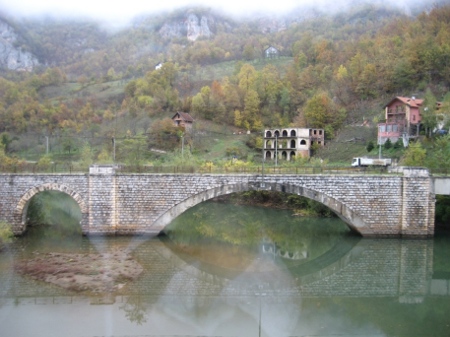The Breakup of Yugoslavia, the War in Bosnia, and the Massacre at Srebrenica
Yugoslavia, a culturally rich and varied federation of six republics, was a peaceful and relatively prosperous country under President Tito, who died in 1980. After Tito's death the country gradually succumbed to the pressures of massive inflation and extreme nationalist movements. This extremism, principally fomented in the mid- and late-1980s in Serbia by President Slobodan Milošević, was then mirrored in Croatia by a nationalist movement led by President Franjo Tudjman.
 Secession by Slovenia and Croatia,
fearing the results of an ever more-aggressive Serbian expansionist
movement, led to attack by the Serbian-dominated Yugoslav army in
mid-1991. The conflict in Slovenia only lasted ten days, after which
Serbian forces withdrew. But the war in Croatia dragged on, and by
the year's end Serbia controlled one third of the country, and over
750,000 people had been displaced.
Secession by Slovenia and Croatia,
fearing the results of an ever more-aggressive Serbian expansionist
movement, led to attack by the Serbian-dominated Yugoslav army in
mid-1991. The conflict in Slovenia only lasted ten days, after which
Serbian forces withdrew. But the war in Croatia dragged on, and by
the year's end Serbia controlled one third of the country, and over
750,000 people had been displaced.
In the spring of 1992, the war started anew in a much more ethnically complex Bosnia-Herzegovina. The largest ethnic populations there, in concentrations scattered throughout the country, were Bosnian Croats, Bosnian Serbs, and Bosnian Muslims, now known as Bosniaks. Bosnian Serbs, with significant logistical and personnel support from neighboring Serbia, took over two-thirds of the country by the end of the year, meanwhile setting up concentration camps for Croats and Bosniaks, and expelling most of them and other non-Serbs from the territory they controlled in a maneuver now known as "ethnic cleansing."
In the course of the war Croats and Bosniaks began fighting each other as well, and the country became militarily divided into three zones of control. The war ended in late 1995 with the Dayton peace agreement, which included a new constitution. The division of the country into two "entities" -- the Serb-dominated Republika Srpska and the Croat-Bosniak-controlled Federation, ratified the wartime division of Bosnia.
The most notorious wartime atrocity (though by no means a great exception to the norm) was the massacre that took place in Srebrenica upon the fall of that enclave, a "UN safe area," in July 1995. In the days following the takeover by extremist Serbs, troops under the control of General Ratko Mladic systematically executed over 8,000 Bosniak men and boys. Their remains are still being exhumed from dozens of mass graves throughout eastern Bosnia.
The war resulted in approximately 100,000 deaths (predominantly Bosniaks), over a million people made refugees, and another million internally displaced persons. The ordinary civilian survivors of the war, victims regardless of ethnicity, are still trying to put their lives back together.